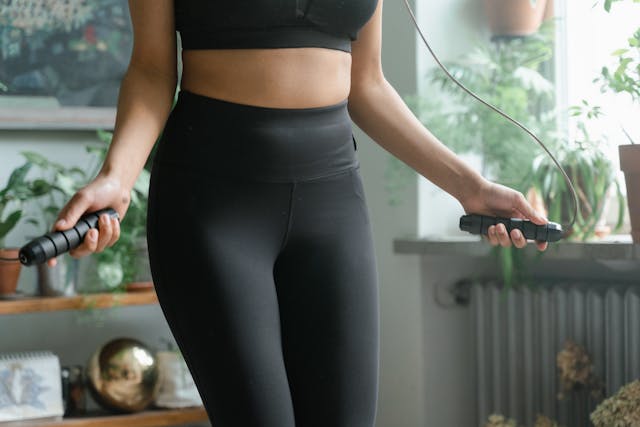Transform your fitness routine without setting foot outside or putting unnecessary stress on your joints. While high-intensity workouts dominate social media, there’s a gentler approach that delivers remarkable results.
Low-impact cardio offers a sustainable path to better health, combining effectiveness with accessibility. Whether you’re dealing with joint pain, time constraints, or simply prefer exercising in your own space, these seven science-backed benefits will show you why gentle movement might be exactly what your body needs right now.
1. Joint-Friendly Fitness That Works
The beauty of low-impact cardio lies in its ability to strengthen your cardiovascular system while protecting your most vulnerable joints. An impressive 54.8% of participants averaged 150 minutes or more of moderate activity per week, with the percentage increasing with age and higher for males.
This proves that gentle exercise isn’t just accessible—it’s preferred by millions who’ve discovered its long-term advantages.
Protect Your Knees, Hips, and Ankles for Life
Your joints weren’t designed to handle endless pounding from high-impact activities. Every time you choose low-impact exercises like walking, cycling, or using a mini trampoline for adults, you’re investing in your future mobility. These activities provide the cardiovascular challenge you need without the jarring force that gradually wears down cartilage.
Traditional running generates forces up to three times your body weight with each step. Compare that to low-impact alternatives that keep pressure minimal while still elevating your heart rate effectively. Your knees will thank you decades from now when you’re still moving pain-free.
Perfect Solution for Arthritis and Chronic Pain Management
Managing chronic pain doesn’t mean giving up on fitness goals. Osteoarthritis, caused by degeneration of the cartilage between joints, affects 32.5 million adults in the US and nearly 600 million adults worldwide. For these individuals, gentle movement often provides more relief than complete rest.
The key lies in promoting blood flow without aggravating inflamed tissues. Water exercises, stationary cycling, and gentle stretching routines can reduce stiffness and improve range of motion. Many people discover that consistent, gentle movement helps them manage pain better than medications alone.
These joint-preservation benefits become even more critical when you consider the sustainable fat-burning advantages that don’t require intense effort.
2. Sustainable Weight Management Without the Burnout
Weight loss doesn’t require punishment. The benefits of low-impact cardio extend far beyond joint protection, offering a sustainable approach to managing your weight without the mental and physical exhaustion that comes with extreme workouts.
Steady Fat Burn That Fits Your Lifestyle
Your body burns fat most efficiently during moderate-intensity exercise. When you’re working at 60-70% of your maximum heart rate, you’re in the optimal zone for using stored fat as fuel. This happens naturally during home cardio workouts that keep you moving at a comfortable pace for extended periods.
Unlike high-intensity sessions that rely heavily on carbohydrates for quick energy, steady-state cardio teaches your body to become a more efficient fat-burning machine. You’ll find that 30-45 minutes of consistent, gentle movement often burns more total calories than shorter, more intense sessions that leave you exhausted.
Hormone-Friendly Approach to Fitness
Extreme workouts can work against your weight management goals by disrupting hormonal balance. High-intensity exercise triggers cortisol release, which can promote fat storage, especially around your midsection. Low-impact cardio, on the other hand, helps regulate stress hormones while supporting healthy insulin sensitivity.
Women, particularly those experiencing perimenopause or menopause, often find that gentle exercise works better than intense training for maintaining a healthy weight. The steady approach supports rather than stresses your endocrine system, making it easier to achieve lasting results.
This hormonal optimization creates a foundation for measurable improvements in your heart health that you can track over time.
3. Cardiovascular Health Gains You Can Measure
Cardio fitness at home isn’t just about convenience—it’s about creating measurable improvements in your heart health through consistent, manageable effort. Your cardiovascular system responds beautifully to regular, moderate exercise that you can sustain week after week.
Heart Rate Training Zone Optimization at Home
Finding your target heart rate zone becomes simple when you’re exercising in the comfort of your own space. Calculate your maximum heart rate by subtracting your age from 220, then aim for 60-70% of that number during your workouts. This sweet spot provides cardiovascular benefits without overexertion.
Home cardio workouts allow you to monitor your effort level closely and make adjustments as needed. You’ll notice improvements in your resting heart rate, blood pressure, and overall circulation as your heart becomes more efficient at pumping blood throughout your body.
To make those measurable gains at home more consistent, consider adding a dedicated piece of kit that supports low-impact work and precise pacing. For many people a compact home treadmill provides controlled, joint-friendly walking or incline workouts that keep you squarely in the target heart-rate zone without the impact of running outdoors. Renting equipment for short periods also lets you trial different sizes and features to find what fits your space and goals. This practical flexibility can help you maintain steady progress while protecting joints and recovery.
Enhanced Recovery and Heart Rate Variability
Regular low-impact movement improves your heart rate variability—a key indicator of cardiovascular health and stress resilience. When you’re not constantly pushing your body to its limits, your autonomic nervous system has time to recover and adapt properly.
Better recovery means improved sleep quality, reduced inflammation, and enhanced immune function. Your heart learns to respond more effectively to daily stressors, both physical and emotional, creating a foundation for long-term wellness that extends far beyond your workout sessions.
As your heart grows stronger and your circulation improves, these physical changes trigger powerful mental and cognitive benefits that extend far beyond the workout itself.
4. Mental Health and Cognitive Performance Boost
The connection between gentle movement and mental wellness runs deeper than most people realize. Low-impact cardio offers unique psychological benefits that high-intensity workouts often can’t match, creating space for mindfulness while strengthening your body.
Mood Enhancement Through Mindful Movement
Unlike exhausting workouts that can sometimes increase stress, gentle cardio promotes the release of feel-good endorphins without overwhelming your system. The rhythmic nature of activities like walking, cycling, or dancing allows your mind to relax while your body moves, creating a meditative effect.
This combination of physical activity and mental calm helps reduce anxiety and depression symptoms. You’ll often find that problems seem more manageable after a gentle workout session, as the steady movement helps process stress hormones and promotes mental clarity.
Brain Health and Memory Improvement
Consistent low-impact exercises promote neuroplasticity—your brain’s ability to form new neural connections throughout life. The increased blood flow during gentle exercise delivers oxygen and nutrients to brain tissue, supporting cognitive function and memory formation.
Regular moderate exercise has been shown to increase the size of the hippocampus, the brain region involved in learning and memory. You might notice improved focus, better problem-solving abilities, and enhanced creativity as these neurological benefits compound over time.
With both your body and mind reaping rewards, you’ll be motivated to discover how low-impact cardio fits seamlessly into even the busiest lifestyles.
5. Time-Efficient Fitness That Adapts to Your Schedule
Modern life demands flexibility, and cardio fitness at home delivers exactly that. You don’t need hours of free time to see real results—just consistency and smart planning that fits your reality.
Maximum Results in Minimal Time Blocks
Even 15-20 minute sessions can provide significant health benefits when done consistently. The beauty of home cardio workouts lies in their adaptability—you can break exercise into smaller chunks throughout the day and still meet your fitness goals.
Morning stretches, lunch break walks, and evening gentle movements all add up to meaningful activity levels. This approach often proves more sustainable than trying to carve out long workout blocks that compete with work and family responsibilities.
No Commute, No Excuses, No Equipment Barriers
Weather, traffic, and gym hours become irrelevant when your workout space is wherever you are. Many effective low-impact exercises require nothing more than your body weight and a small floor space, making consistency achievable regardless of circumstances.
The time you save on commuting to a gym can be invested in longer workouts or other healthy activities. This convenience factor alone helps many people maintain their fitness routines long-term, as external barriers to exercise virtually disappear.
The convenience factor becomes even more appealing when you consider the substantial financial advantages of building your fitness routine at home.
Equipment Comparison for Home Success
| Equipment Type | Initial Cost | Space Required | Family-Friendly | Versatility | Maintenance |
| Mini Trampoline | $80-200 | 4×4 feet | High | Moderate | Low |
| Resistance Bands | $20-50 | Minimal | High | Very High | Low |
| Yoga Mat | $25-75 | 6×2 feet | High | High | Low |
| Stability Ball | $15-40 | 3×3 feet | Moderate | High | Low |
| Walking/Marching | Free | Any space | Very High | Moderate | None |
Your Path Forward with Low-Impact Cardio
These seven benefits demonstrate why millions are choosing gentler approaches to fitness that honor their bodies while delivering real results. Low-impact cardio isn’t about settling for less—it’s about choosing sustainability over intensity, consistency over perfection. Whether you’re protecting existing joints, managing chronic conditions, or simply seeking a more enjoyable way to stay active, this approach offers everything you need for lifelong wellness. Start where you are, use what you have, and remember that small, consistent steps create the biggest transformations over time.
Your Questions About Low-Impact Home Cardio Answered
1. What is the 15 15 15 cardio workout?
The 15-15-15 workout involves 15 minutes each of spinning, elliptical work, and treadmill running for a total of 45 minutes of back-to-back cardio exercise.
2. Is 30 minutes of low-intensity cardio enough?
Yes, 30 minutes of daily cardio is generally safe and effective for most people when combined with strength training throughout the week.
3. Can I lose weight with just low-impact cardio?
Absolutely. Consistent low-impact cardio burns calories, improves metabolism, and supports sustainable weight management when paired with healthy eating habits.




